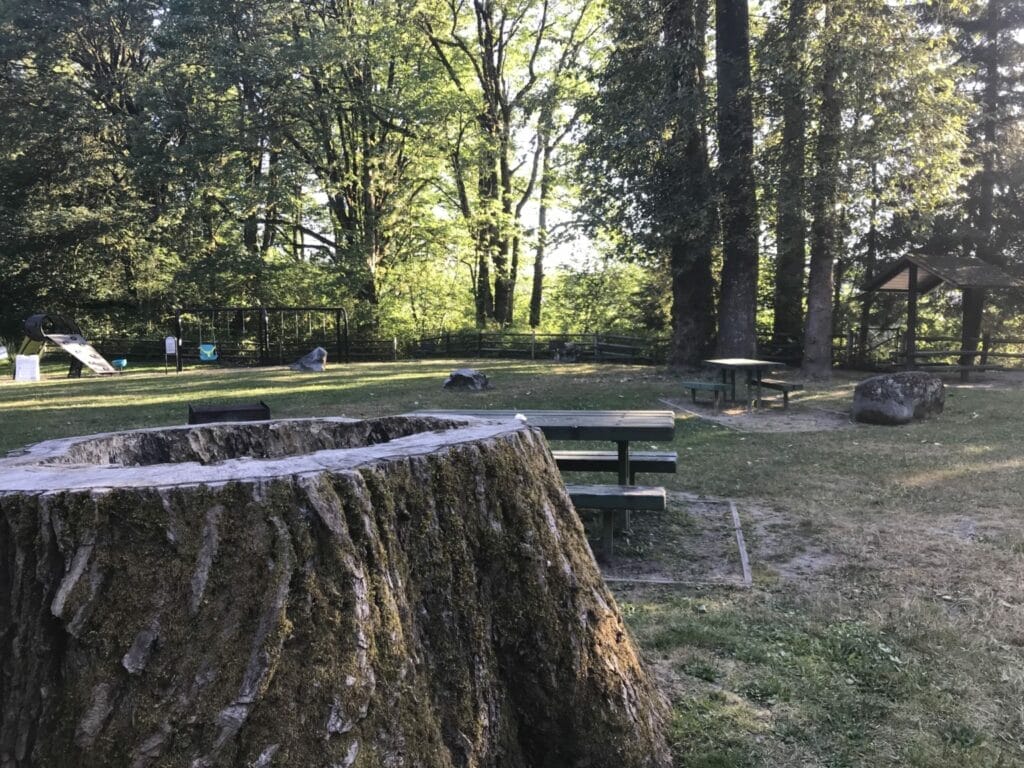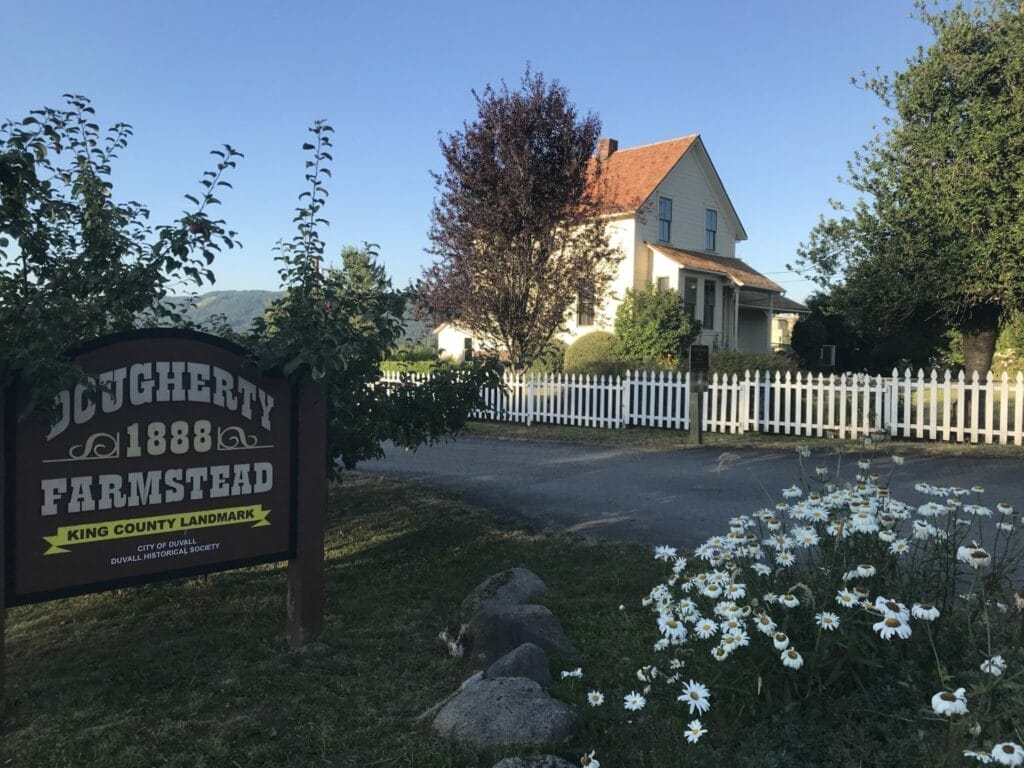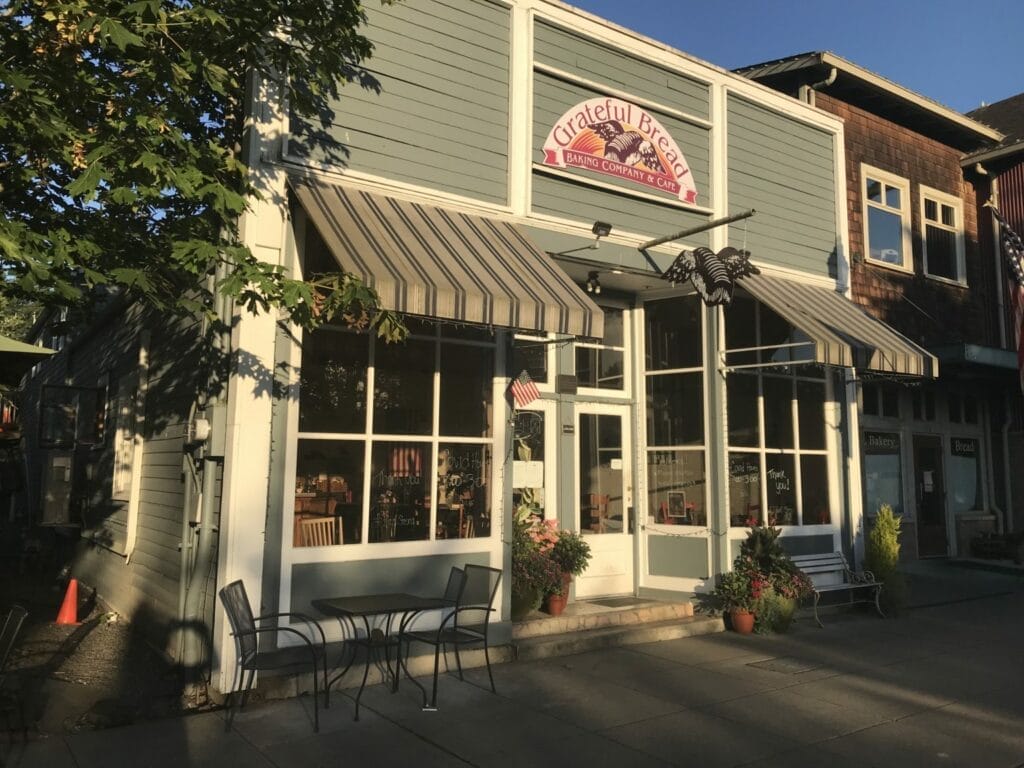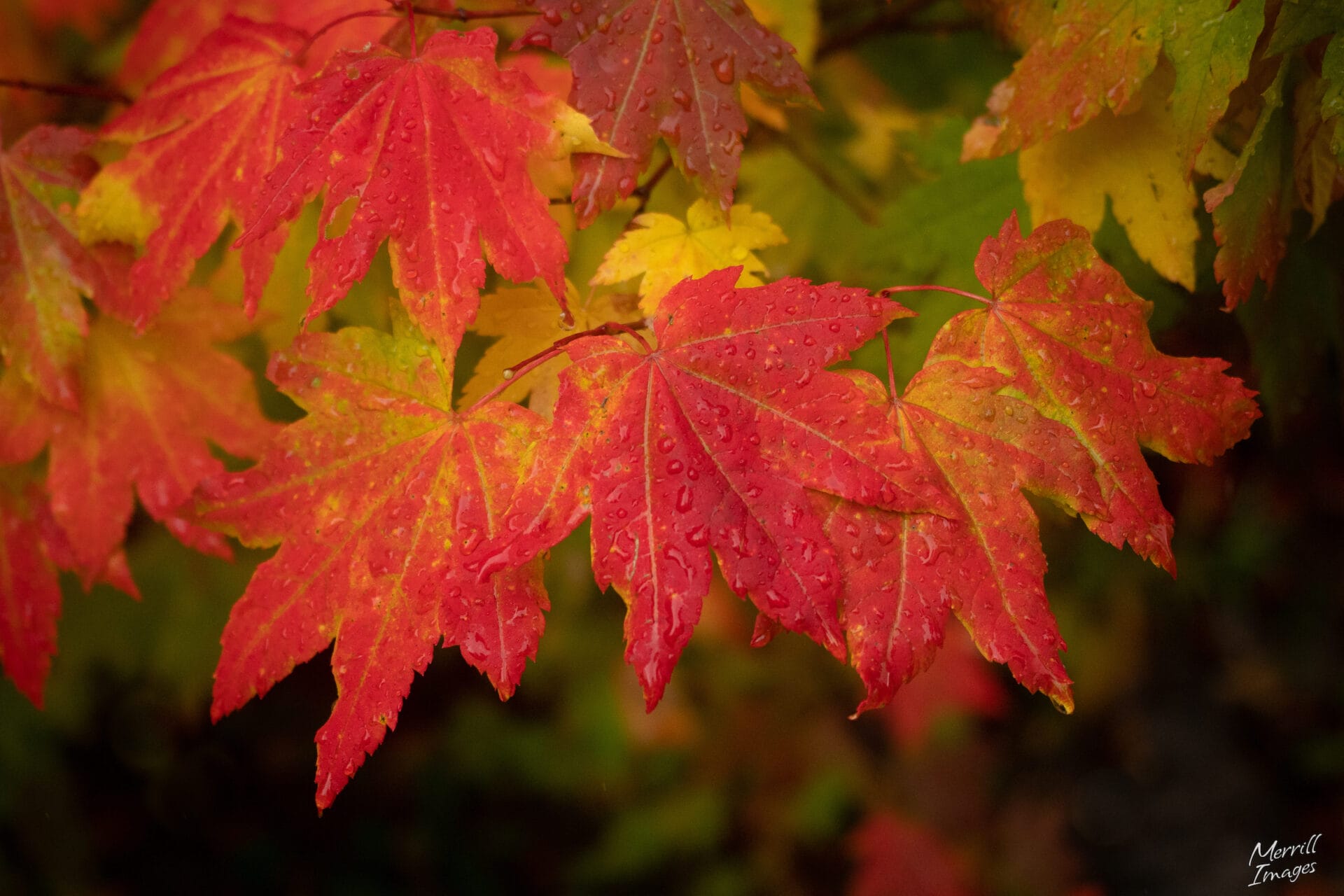Duvall Historic Walking Tour
Duvall’s history has many interesting stories including the moving of the town, the bailing out of graves, and the winning of a tavern in a poker game. In our fun, self-guided tour of downtown Duvall you learn about its historic buildings and the stories they have to share. Click on the links for each stop to see historic photos. The 4Culture King County Lodging Tax provided generous support for the development of this tour.
Itinerary
-
Depot Park
Start your day at Depot Park – its free public parking lot provides a great place to leave your vehicle while you enjoy your walk. If you need a snack or hot beverage before you start, head up the hill one block to Main Street to find an array of coffeeshops and cafes.
The first stop is at Duvall’s Historic Railroad Depot located immediately downhill from the parking lot. Built in 1911, the Duvall Depot originally sat closer to the river, adjacent to the railroad tracks. In 2001, owner Ray Burhen donated it to the City of Duvall. Moved to its current spot to preserve it for public enjoyment, the Depot now serves as a community meeting space.

Duvall’s Historic Railroad Depot -
Snoqualmie Valley Trail
Head downhill to the Snoqualmie Valley Trail and take a right (heading north). This trail sits on the original rail line for the Chicago, Milwaukee and St. Paul Railway. In the 1960’s, the rise of automobiles and challenging government regulations led the Railway, like many others across the country, to abandoned its rails. You can read more about the influence of railroads in Duvall and the Snoqualime Valley in our blog How the Railroad Built Duvall.
In the 1980’s, King County Parks acquired the rail line through the Snoqualmie Valley and converted it to the Snoqualmie Valley Trail. The Snoqualmie Valley Trail is the single longest trail in King County’s Regional Trail System. At 31 miles long, it runs from Duvall to Rattlesnake Lake where it connects to the Palouse to Cascades State Park Trail that runs to Eastern Washington. A future vision connects the Snoqualmie Valley Trail to the Centennial Trail through Monroe and Snohomish.
-
Taylor Landing Park
Walk north along the Snoqualmie Valley Trail and in about 1/5 mile you will cross under the Woodinville-Duvall Road and see the Duvall Park & Ride on the right. About 175 feet ahead the trail veers to the left and drops down into Taylor Landing Park.
The original community, named Cherry Valley, sat on the banks of the Snoqualmie River at this location. Cherry Valley centered around a market, grange hall, church, and a school which had been constructed from the wood of a single old growth log. Mostly isolated from the larger Seattle-Tacoma region, it relied on boats as the main mode of transportation for timber, farm goods, and people. A swing bridge installed in 1905 provided a connection between Cherry Valley and the Woodinville area.
Plans for the construction of the Great Northern and Chicago, Milwaukee and St. Paul railroad line along the river pointed right to where Cherry Valley sat. During construction, the railroad helped move homes and businesses up the hill to their present location. For a short period of time the new town was named Cosgrove (after a Washington governor) until they discovered another Washington town had already claimed the name. The new, new name – Duvall – honored Francis and James Duvall, loggers who had a homestead on the hillside when they arrived in 1871.

Cherry Valley Schoolhouse 
Taylor Landing Park -
Cherry Valley Pioneer Cemetery
From Taylor Landing Park, reverse course on the Snoqualmie Valley Trail back to the Park & Ride. Head up hill on the sidewalk between the Park & Ride and the Woodinville-Duvall Road Bridge. Cross over Main Street (Highway 203) and turn left (north). In about 600 feet, veer left onto Cherry Valley Road and head up the hill about 1/5 mile to where the road bends to the right. The Cherry Valley Pioneer Cemetery once sat in the wooded area on the northwest side of the road.
In 1886, original homesteader James O’Leary deeded an acre of land to the Squak Methodist Mission for a church and cemetery. Duvall’s early pioneers used the cemetery behind the church for just a few short years because natural springs from the upper slopes kept the ground constantly wet and soggy. Mourners found it disconcerting to see gravediggers furiously bailing several inches of water before lowering the casket. Townsfolk abandoned the site as a burial ground sometime between 1902 and 1905.
To further complicate things, the Great Northern Railroad had to excavate part of the cemetery in 1909 and 1910 as a portion of the hillside sat in the railroad right-of-way. The Railroad moved about 20 bodies to other cemeteries during the process. You can read more about the cemetery here.

Marker in Cherry Valley Pioneer Cemetery -
Dougherty Farmstead
Continue a little further on Cherry Valley Road to Dougherty Farmstead on the left at the top of the hill. In 1886, James O’Leary originally purchased the homestead that would become this farmstead. The Dougherty house, originally built near the river in the town of Cherry Valley, was moved up the hill in 1910, pulled by horses. In 1898, John and Kate Dougherty purchased the house and their family lived there until 1983 when Leo Dougherty died.
With a grant from King County, the Duvall Historical Society began preservation work on the house in 1985. It has immense historic integrity as a 19th century farmhouse, unaltered for 100 years. The original walls, doors, windows, woodwork, staircase, and exterior siding remained. In addition to the house, the property also includes the milk house and the bunkhouse where Kate Dougherty, then a widow with eight children, boarded eight loggers.
One acre of the Dougherty farmstead including the house is both a King County and National Landmark. You can go inside the house every Sunday 1pm to 4pm from May through September.

Dougherty House, c1900, courtesy of the Duvall Historical Society 
Dougherty House, 2020 -
Duvall Tavern
Now head back back down Cherry Valley Road to Main Street / Highway 203. Stay on the eastern side of Highway 203 and walk south towards downtown.
As you approach Stewart Street notice the Duvall Tavern across the street. Built in 1934, just a year after prohibition, this Tavern has remained in operation ever since. The parking lot on its south side sits on land once occupied by a ramp to the old Stewart Street Bridge that crossed the Snoqualmie River towards Woodinville. In 1963, The Duvall Tavern changed ownership three times in two days. A well-known Valley gambler won it in a poker game and then sold it to another gambler to pay off a gambling debt. That second gambler then sold it to another person who actually wanted to be in the tavern business.

-
Lon Brown's Home
Cross over SE Stewart Street to the second building on the left, Lon Brown’s home, built in 1914. Brown, the first mayor of Duvall and a colorful entrepreneur, ran a silent movie theater and the confectionary across the street. The building subsequently housed Trim’s Meats, Cherry Valley Plumbing, and currently EarthHeat Geothermal Energy Systems.

-
Aimer's Blacksmith Shop
Just next door to the south you’ll find Aimer’s Blacksmith Shop (later L.D. Smith Blacksmith Shop) built in 1909 when the town had its short-lived time named Cosgrove. L.D. Smith purchased the business in 1913. It fashioned horseshoes and repaired farm equipment. The building subsequently housed a gymnasium and an art shack. Bella Couture Parlor currently occupies the space.

Newspaper clip courtesy: Duvall Historical Society 
Building that once housed Aimer’s Blacksmith Shop -
Hoffman's Duvall Tailoring Company
Continue next door to Red Pepper Pizzeria. Built in 1911 or 1912, this building originally housed Hoffman’s Duvall Tailoring Company. Mr. Hoffman hiked out to logging camps, taking orders and measurements for some classy suits. Customers would then drop in on Saturday night for a final fitting. The building has also served as the original Silver Spoon Restaurant, a barbershop, an antique shop, and an arcade.
-
Hix's General Merchandise
The next building, currently Duvall Flower and Gifts, is the oldest building in town. Built in 1905, it housed Hix’s General Merchandise. Originally built on the river in the town of Cherry Valley, it moved to its current location in 1910 when railroad planners laid out tracks that would have come through its front door and out the back. The move took six weeks. The building has served as a general store, the Post Office, and later as Duvall Auto Parts.

Hix’s General Merchandise appears on the far left, courtesy of the Duvall Historical Society 
-
Duvall State Bank
Cross Cherry Street to Studio Beju, originally the Duvall State Bank built in 1912, and later a branch of the Bank of America. Three men with blazing pistols, aided by one man acting as a lookout, robbed the bank of $435 in 1915. Once nearby citizens and the town marshal noticed the robbery, a gun battle ensued with shots fired from every direction. The leader of the robbers, with loot in a pillowcase, headed for the river. Shots continued to ring out and a splash was heard. The pillow case containing the gold and an empty pistol were all that were found.

Courtesy of the Duvall Historical Society 
-
Franke's Shoe Store
Grateful Bread Cafe currently occupies the next building. Built in 1913, it originally housed Franke’s Shoe Store where Joseph Franke made and repaired shoes (including the caulked boots for loggers). Later, the building served as the office of Judge Wright, the grandfather of Broadway star Martha Wright. Later still, it served as the home of the Carnavall Reporter newspaper, a florist shop, the Pumps and Grinds Coffee Shop, and the Duvall Coffeehouse.

Courtesy of the Duvall Historical Society 
-
Boyd's Grocery
Head back north to Cherry Street and cross Highway 203 / Main Street to find the Pacific Bike and Ski Shop. Originally Boyd’s Grocery, this 1912 building initially contained a grocery store as well as a bakery and Post Office. In the 1930’s, cold storage lockers replaced the bakery. Subsequent occupiers included Stretch’s, McDougal’s General Store and the quirky Duvall Book Store, which closed in 2016. The Book Store attracted visitors from afar, not only for its quality collection of used books, but as a cultural attraction that included displays of historic and eclectic memorabilia in an old-fashioned atmosphere with neither telephone nor cash register.

Courtesy of the Duvall Historical Society -
Duvall Library
Head south to the next building, the Duvall Visitor’s Center. The Duvall Civic Club first operated the Duvall Library in this building, constructed in the 1930s with WPA (Works Progress Administration) funds. The Club obtained the Library’s first 71 books by traveling to Seattle and scouring second hand bookshops. Read more about the Library’s history at HistoryLink.

Duvall Civic Club photo for Seattle P.I. February 6, 1948, courtesy Duvall Historical Society 
Duvall Visitor’s Center -
The Grange
Next door you’ll find The Grange. The Independent Order of Oddfellows Duvall Lodge #311 constructed this building in 1926, where it subsequently hosted weekly dances. The Grange purchased the building in 1933, and it remained as the social center of town for years including serving as the home for Klondike Days, a big local event. In 1977 it became the famous Silver Spoon, serving up arts and crafts as well as fine food and amazing live music upstairs after dinner. Local artists sold pottery and art throughout the dining room where customers sat at tables covered with vintage strawberries, violets, poinsettias and state maps.

Courtesy of the Duvall Historical Society 
-
McCormick Park
Continue one block south to Stephens Street and take a right to get back to your car. You can also take a few minutes to hang out by the river at McCormick Park and contemplate all the places and stories of Duvall’s past.



























